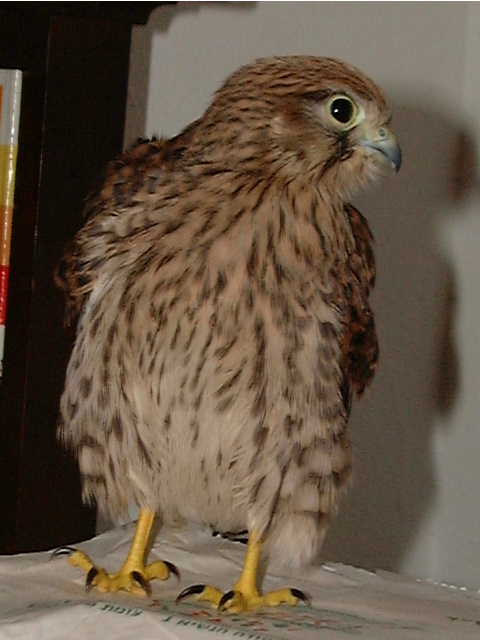Kestrel - European
Common Kestrel, Windhover, Eurasian Kestrel Scientific Name: Falco tinnunculus
Fri, 1st November, 2024 - 10:40 am GMT
Sponsor Ads:

Alternative Name
Common Kestrel, Windhover, Eurasian Kestrel Scientific Name: Falco tinnunculusBasic Info
By maturity, most European Kestrels are between 13 and 15 inches (33 to 39 centimeters) in length. Females are often slightly larger than males. The wingspan usually reaches about 26 inches (70 centimeters). Both sexes have brownish plumage and relatively long, pointed wings. Often, males' feathers are more rufous in color than those of females, and some birds show deep russet or chestnut shades. The heads and tails of males are bluish gray. A black tip accents the long tail. Black stripes also decorate the beautiful faces of both sexes of European Kestrels.
Health
European Kestrels are not often used as beginning falconers' birds anymore. This is because larger hawks are available for use that can catch more substantial prey than kestrels. Larger hawks may also be more easily maintained; because European Kestrels are so small, their metabolisms are very quick. It is essential that they be weighed regularly to be sure they are maintaining healthy weights. European Kestrels may be fed pounded chicken parts in addition to white mice. When hunted, they are often used to capture voles, though they may also return with insects for their handlers. Breeding European Kestrels do not build their own nests; rather, they will take over existing nests. They often readily accept man made nesting boxes and can tolerate disturbance well. These birds have been noted raising hatchlings in such odd places as cowsheds, ledges of office buildings, and railroad structures. Between four and five eggs are usually deposited once the European Kestrel has returned to its summer breeding ground, often near the end of April.Habitat
N/ABehavior
The European Kestrel is a beautiful little raptor. Commonly used in falconry and well -known throughout their migratory range, these lovely birds are a joy to watch in flight or on the hunt. The migratory pattern of the European Kestrel is fairly simple. Birds summering in northerly regions simply move to southern regions. Very different from low hunting flight behaviors, migratory flight occurs high in the sky. European Kestrels have amazed observers for centuries by their ability to hover 20 to 30 feet in the air at a stationary locus, even in the face of wind! This hovering enables the kestrel to look for food; if it finds none, it will circle or fly forward before hovering again. European Kestrels may also hunt from a perch, like a tree or telephone pole. Once prey is sighted, the kestrel folds it wings and dives straight toward the ground, pulling itself out of the free fall just before it hits the ground and lunging forward to obtain its prey item. The prey is a small mammal or bird; commonly voles are taken. European Kestrels are also known for catching insects. They do not seem to prefer a particular type of habitat and have been noted in many regions including coastal marshes, open wooded areas, agricultural regions, and large cities.Origin
Europe and AsiaHistory
European Kestrels are native to almost all regions of Europe and Asia. Perhaps best known for their traditional use in falconry, the European Kestrel has been a beginner's bird for many years. Recently, larger birds have replaced this little falcon's duty with learners, but many still love the European Kestrel for sentimental reasons. The European Kestrel is a familiar sight for many that live within its range. It has been noted in suburban areas as well as fields and wilds and has been immortalized in Gerard Manley Hopkins' well-known poem, "The Windhover". In agricultural areas, some farmers will set up nesting boxes for these little raptors in order to have an effective form of pest control.Common Foods
N/ASponsor Ads:
"Country in which there are precipitous cliffs with torrents running between, deep natural hollows, confined places, tangled thickets, quagmires and crevasses, should be left with all possible speed and not approached." -- Sun Tzu, The Art of War
Kestrel - European
Coded by: BGID® | ALL RIGHTS RESERVED Copyright © 2000-2024
Disclaimer | Privacy | Report Errors / Contact | Credits

 President of the United States of America - Real Estate mogul, Pageant owner and now one of the most controversial men in political history.
President of the United States of America - Real Estate mogul, Pageant owner and now one of the most controversial men in political history.  Politician, US Vice President and President of the USA - Joseph Robinette Biden Jr.
Politician, US Vice President and President of the USA - Joseph Robinette Biden Jr.  versus
versus  Russia: 'The Evil Empire'? Are they all that bad or is it just the USA trying to portray Russia as bad because they are a world power with land bigger and a society very different from the USA ideal?
Russia: 'The Evil Empire'? Are they all that bad or is it just the USA trying to portray Russia as bad because they are a world power with land bigger and a society very different from the USA ideal?  Global warming has been in and out as the "latest" hot topic for many years. It is, according to modern scientists, the result of man-made industrial pollutants, clearing forested areas, agriculture, etc. But now they are thinking it started way before the Industrial Revolution...
Global warming has been in and out as the "latest" hot topic for many years. It is, according to modern scientists, the result of man-made industrial pollutants, clearing forested areas, agriculture, etc. But now they are thinking it started way before the Industrial Revolution... 
 Corona virus
Corona virus 
 Users with wide screen monitors can benefit from more content on every page.
Users with wide screen monitors can benefit from more content on every page.